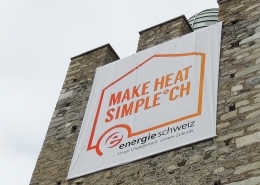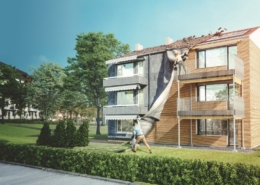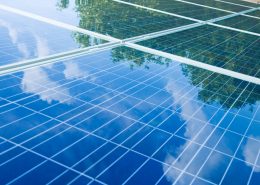The "Atomic Pope" - How Michael Kohn shaped Swiss energy policy
The historian and journalist Karl Lüönd has published a biography of Michael Kohn. The result is a captivating portrait of one of the most influential figures in Swiss energy policy in recent decades.
As a powerful manager of Motor-Columbus AG, Michael Kohn became a hate figure of the anti-nuclear movement in the 1970s. For decades he was at the centre of energy policy debates in Switzerland. He was a fervent advocate of nuclear energy, a believer in technical progress, a man who sought out disagreement with dissidents, who always fought for his cause with great passion, and who was not afraid to defend unpopular positions in public.
The construction of power plants as a patriotic duty
In many respects, his career was exemplary for the development of energy supply in Switzerland after the Second World War. The son of Jewish immigrants from Eastern Europe, he was born in Zurich in 1925. From 1944 to 1948 he studied civil engineering at the ETH Zurich. In 1950 he then found his first job at the Swiss Federal Laboratories for Materials Testing (Empa) in the field of concrete testing, before working for Motor-Columbus AG in 1953 on the construction of the dam in Zervreila in the canton of Graubünden.
In the 1950s there was an unbridled belief in progress. Strong economic growth led to a steady increase in energy consumption. At the time, the young civil engineer saw his work as a patriotic duty: "Building power plants was a patriotic mission in those times. For us, there was nothing more important than building and thus solving the electricity shortage that had been lamented for years. We knew full well that new power plants would create the conditions for the expansion of industry, for public transport, for domestic comfort. We were driven by the idea of building up and providing energy because it powered human civilization," he later recalled.[1]
From the Swiss high mountains to the Israeli desert
In 1957, Kohn moved from the Swiss high mountains to the Middle Eastern desert sands. He went to Israel, where he worked as a construction manager on a canal system that carried water from the Sea of Galilee region in the north to the arid south in the Negev desert. As a Jew and a staunch Zionist, he wanted to bring his knowledge of hydroelectric construction to Israel. While visiting a construction site near the Syrian border, the Swiss ambassador warned him: "Never wear a white shirt there! You would make it too easy for the snipers!"[2] His involvement, which lasted until 1960, served to build up the new state of Israel, but at the same time it also benefited Swiss industrial companies, which were able to supply their electromechanical equipment to the Israeli desert.
After his return from Israel, he initially supervised Motor-Columbus AG's projects in South America and then climbed steeply up the career ladder to become a director. As a member of the board of directors, he built up a nuclear technology department from 1964 and from 1966 planned a nuclear power plant in the municipality of Kaiseraugst in the extreme northwest of the canton of Aargau. "There was still a huge hunger for electricity in Switzerland, and we were fighting for every water concession in the Alps. At the same time, we had to admit that the possibilities there were slowly but surely running out. And since the electricity industry is an industry with decidedly long planning cycles, I felt it was my job to look around the world and think ahead," he said in retrospect.[3]
The "Atomic Pope" as the bogeyman of the anti-nuclear movement
Since the 1960s, Kohn had been one of Switzerland's staunchest advocates of nuclear energy, which is why he was nicknamed the "Atomic Pope". In 1975, following the occupation of the construction site of the planned nuclear power plant in Kaiseraugst by opponents of nuclear power, he said: "But Kaiseraugst has perhaps become a symbol and a touchstone for whether the idea of the rule of law can be upheld even in a complex matter, and whether an objective, factual discussion without emotion can be found in the solution of large, demanding tasks in our state. If this succeeds, Kaiseraugst could become a cleansing thunderstorm; if not, a precarious beginning of emotionalization and savagery in the political process."[4]
As chairman of the board of Motor-Columbus AG, Kohn became the bogeyman of the AKW opponents. On the night of May 19-20, 1979, his Chevrolet Camaro was destroyed in an arson attack in an underground parking garage in Zurich. Two days later, a further six cars belonging to representatives of the electricity industry were set on fire in German-speaking Switzerland and Ticino. Kohn had to armour his apartment door and surround himself with bodyguards. With the terror, the left-wing extremists tried to intimidate the representatives of the energy industry. In a pamphlet they declared: "Their displayed technical and administrative superiority must begin to shake. It must be shown that these gentlemen, bristling with arrogance, are nothing other than the new wizards of capital, the masterminds of a new anti-life development, a qualitatively new domination over labor power."[5]
The ideological division of society
From the mid-1970s, nuclear energy divided society. Proponents and opponents fought each other in a bitter religious war. A compromise hardly seemed possible any more; on the contrary, the antagonisms intensified. "The disputes that the electricity industry is waging today, or should be waging, revolve only superficially around the question of power plants, radioactivity and disposal. Those are just the first names. It is also about the form of society and life that corresponds either to our value system or to that of our adversaries," Kohn said in 1982.[6] The ideological power struggle at times threatened to escalate into violent confrontations. Left-wing extremist groups within the anti-nuclear movement turned to terrorism in the late 1970s, while at the same time radical right-wing vigilante groups threatened vigilante justice.
The accidents at Three Mile Island in 1979 and Chernobyl in 1986 led to a steady decline in the acceptance of nuclear power. In 1988, the planned nuclear power plant at Kaiseraugst was finally buried, and in 1990 a majority of voters approved a ten-year freeze on the construction of new nuclear power plants. Twenty years after the super-GAU in Chernobyl, however, approval of nuclear energy was again as high as before. In 2006, on the occasion of the 20th anniversary of Chernobyl, Kohn said, "I am in favour of nuclear energy out of conviction," and while pointing to the cooling tower of the Gösgen nuclear power plant, he said, "This plant here is proof of reliability after all - it runs like an Örgeli."[7]
A long-term strategy for Switzerland's energy supply
In 1973, the oil crisis had drastically demonstrated to Switzerland its dependence on energy imports. After the outbreak of the Yom Kippur War, the main Arab states had turned off the oil tap to punish the Western industrialized countries for their pro-Israeli policies. Oil accounted for nearly 80 percent of energy consumption in Switzerland at the time. Oil became scarce and expensive. The affected countries reacted with austerity measures, petrol rationing and speed restrictions, and the Federal Council also decreed three car-free Sundays at the time due to the supply bottlenecks in Switzerland.
In 1974, SP Federal Councillor Willi Ritschard then set up the Overall Energy Commission (GEK), which was to draw up a long-term strategy for Switzerland's energy supply for the first time. He entrusted Kohn with the presidency of the GEK. At the time, the energy industry expected at least 15 to 20 new nuclear power plants to be built in Switzerland by the year 2000. However, due to political pressure from the anti-nuclear movement, the demand forecasts had to be revised in the late 1970s. In 1978, the GEK recommended a limitation of the originally planned construction programme, but still considered the demand for the immediately planned nuclear power plants to be given.
The GEK developed 13 possible energy policy scenarios - from ultra-liberal to total nationalisation - and analysed their probable economic, financial, ecological, social and political consequences. On this basis, the energy article for the Federal Constitution was subsequently drafted, which initially failed by a narrow majority of the cantons in 1983, but was adopted by a large majority in 1990. The principles formulated at that time - "saving, researching and substituting fossil fuels" - are still valid today. Saving energy, promoting renewable energies, substituting fossil energies, research and development, and the central importance of a high level of security of supply are still important cornerstones of Swiss energy policy today.
Anti-Semitism and dormant assets
Due to his family's Jewish origins, Kohn was confronted with anti-Semitic hostility since his youth. For years, the family lived on packed suitcases. "We knew: It could hit us, fatally, soon. We were ready to go wherever..." he later recalled.[8] His father had come to La Chaux-de-Fonds from Poland before the First World War to learn the watchmaking trade. But since he could not find a job, he rattled around the fairs in Switzerland selling clothes. After some initially difficult years, he was finally able to buy a shop on Langstrasse in Zurich. As an adolescent, Kohn helped out in his father's business. He experienced the inflammatory slogans of the "Fröntler" at first hand in the late 1930s. Once he had to scrape off a poster from the window of their shop on which was written: "Don't buy from the Jews!"[9]
From 1988 to 1992, Kohn was president of the Swiss Federation of Jewish Communities (SIG). For him, commitment to the Jewish community in Switzerland was also a return to his family Jewish roots. In the early 1990s, the Holocaust issue and dormant assets became politically virulent in Switzerland. Through his parents, Kohn also knew many stories of disappeared funds in Swiss bank accounts. In 1995, the value of the dormant Jewish assets incorporated by Swiss banks was estimated at over 40 million Swiss francs. At that time, Kohn advocated a factual clarification of the matters and an understanding between the Jewish organizations and the Swiss banks and authorities.
For his biography "The Energy Pope", historian Karl Lüönd conducted numerous interviews with Kohn, who died in 2018 at the age of 93. The book thrives on his recollections, which the author skilfully places in the context of Swiss history. The excitingly written portrait tells the eventful biography of Kohn, but at the same time also the history of Swiss energy policy from the end of the Second World War to the new millennium. The richly illustrated book is a profitable read for anyone who wants to better understand the historical origins of our current energy policy.
Michael Fischer,
Sync and corrections by n17t01
[1] Karl Lüönd: The energy pope. Wirken, Werk und Werte von Michael Kohn. Schweizer Pioniere der Wirtschaft und Technik, vol. 117. Zurich: Verein für wirtschaftshistorische Studien, 2020, p. 27.
2] Karl Lüönd 2020, p. 33.
3] Karl Lüönd 2020, p. 35.
4] Quoted from Patrick Kupper: Atomenergie und gespaltene Gesellschaft. The history of the failed Kaiseraugst nuclear power plant project. Zurich: Chronos Verlag, 2003, p. 223.
5] Quoted from Ulrich Fischer: Brennpunkt Kaiseraugst. The prevented nuclear power plant. Bern: Interforum, 2013, p. 107.
6] Karl Lüönd 2020, p. 90.
[7] Quoted from Thomas Angeli: Der Tag, an dem die Wolke kam. In: Beobachter, 27.3.2006.
8] Karl Lüönd 2020, p. 20.
9] Karl Lüönd 2020, p. 19.
 Zentralbibliothek Zürich (ZB), 000_015_442.
Zentralbibliothek Zürich (ZB), 000_015_442.
 8 Vote(s), Durchschnitt: 4,88
8 Vote(s), Durchschnitt: 4,88 EnergieSchweizDas Chalet bequem via Fernbedienung heizen
EnergieSchweizDas Chalet bequem via Fernbedienung heizen  Agir aujourd’hui pour la Suisse de demain
Agir aujourd’hui pour la Suisse de demain  Fluxif / Das Gebäudeprogramm«Der Umbau der Energieversorgung ist machbar»
Fluxif / Das Gebäudeprogramm«Der Umbau der Energieversorgung ist machbar»  ShutterstockEnergiestadt: Konzept wird erfolgreich in Südamerika umgesetzt
ShutterstockEnergiestadt: Konzept wird erfolgreich in Südamerika umgesetzt 
 BFE
BFE © 3S Solar Plus SA/Prix Solaire Suisse 2019
© 3S Solar Plus SA/Prix Solaire Suisse 2019
Wäre es denkbar, dass da etwas mit der Bildunterschrift schief gelaufen ist? Das Bild zeigt doch den betagten Herrn Kohn auf einer Wiese im Osten des Kühlturms von KKG und muss später als 1979 aufgenommen worden sein. Das Bild bei der Überschrift hingegen zeigt das Modell eines Druckwasserreaktors vom Typ KKG, wie es heute im Besucherzentrum zu sehen ist.
Vielen Dank für die Beobachtung. Wir haben die Bildunterschrift aus dem Bild entfernt, weil sie auf dem falschen Bild war.
Ich wünsche Ihnen einen schönen Tag.
Team Energeiaplus